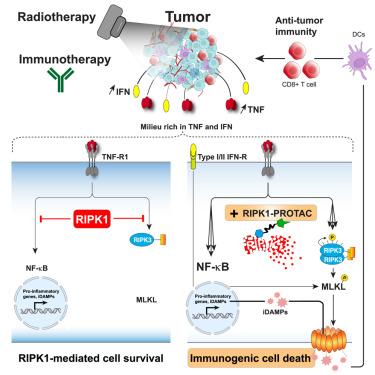Immunity ( IF 25.5 ) Pub Date : 2024-05-23 , DOI: 10.1016/j.immuni.2024.04.025 Jonathan Mannion 1 , Valentina Gifford 1 , Benjamin Bellenie 2 , Winnie Fernando 1 , Laura Ramos Garcia 1 , Rebecca Wilson 1 , Sidonie Wicky John 1 , Savita Udainiya 1 , Emmanuel C Patin 3 , Crescens Tiu 1 , Angel Smith 1 , Maria Goicoechea 1 , Andrew Craxton 4 , Nathalia Moraes de Vasconcelos 1 , Naomi Guppy 1 , Kwai-Ming J Cheung 2 , Nicholas J Cundy 2 , Olivier Pierrat 2 , Alfie Brennan 2 , Theodoros I Roumeliotis 5 , Graeme Benstead-Hume 5 , John Alexander 1 , Gareth Muirhead 1 , Scott Layzell 6 , Wenxin Lyu 7 , Victoria Roulstone 3 , Mark Allen 8 , Holly Baldock 8 , Arnaud Legrand 1 , Florian Gabel 2 , Natalia Serrano-Aparicio 2 , Chris Starling 1 , Hongyan Guo 9 , Jason Upton 10 , Mads Gyrd-Hansen 7 , Marion MacFarlane 4 , Benedict Seddon 6 , Florence Raynaud 2 , Ioannis Roxanis 1 , Kevin Harrington 3 , Syed Haider 1 , Jyoti S Choudhary 5 , Swen Hoelder 2 , Tencho Tenev 1 , Pascal Meier 1

|
Receptor-interacting serine/threonine-protein kinase 1 (RIPK1) functions as a critical stress sentinel that coordinates cell survival, inflammation, and immunogenic cell death (ICD). Although the catalytic function of RIPK1 is required to trigger cell death, its non-catalytic scaffold function mediates strong pro-survival signaling. Accordingly, cancer cells can hijack RIPK1 to block necroptosis and evade immune detection. We generated a small-molecule proteolysis-targeting chimera (PROTAC) that selectively degraded human and murine RIPK1. PROTAC-mediated depletion of RIPK1 deregulated TNFR1 and TLR3/4 signaling hubs, accentuating the output of NF-κB, MAPK, and IFN signaling. Additionally, RIPK1 degradation simultaneously promoted RIPK3 activation and necroptosis induction. We further demonstrated that RIPK1 degradation enhanced the immunostimulatory effects of radio- and immunotherapy by sensitizing cancer cells to treatment-induced TNF and interferons. This promoted ICD, antitumor immunity, and durable treatment responses. Consequently, targeting RIPK1 by PROTACs emerges as a promising approach to overcome radio- or immunotherapy resistance and enhance anticancer therapies.
中文翻译:

RIPK1 特异性 PROTAC 降解剂通过增强免疫原性细胞死亡来实现有效的抗肿瘤活性
受体相互作用丝氨酸/苏氨酸蛋白激酶 1 (RIPK1) 作为协调细胞存活、炎症和免疫原性细胞死亡 (ICD) 的关键应激哨兵发挥作用。尽管 RIPK1 的催化功能是触发细胞死亡所必需的,但其非催化支架功能可介导强的促生存信号传导。因此,癌细胞可以劫持 RIPK1 以阻止坏死性凋亡并逃避免疫检测。我们生成了一种小分子蛋白水解靶向嵌合体 (PROTAC),它可以选择性降解人类和小鼠 RIPK1。 PROTAC 介导的 RIPK1 耗竭会解除 TNFR1 和 TLR3/4 信号中枢的调节,从而增强 NF-κB、MAPK 和 IFN 信号传导的输出。此外,RIPK1 降解同时促进 RIPK3 激活和坏死性凋亡诱导。我们进一步证明,RIPK1 降解通过使癌细胞对治疗诱导的 TNF 和干扰素敏感,增强了放射治疗和免疫治疗的免疫刺激作用。这促进了 ICD、抗肿瘤免疫力和持久的治疗反应。因此,通过 PROTAC 靶向 RIPK1 成为克服放射或免疫治疗耐药性并增强抗癌治疗的有前途的方法。











































 京公网安备 11010802027423号
京公网安备 11010802027423号